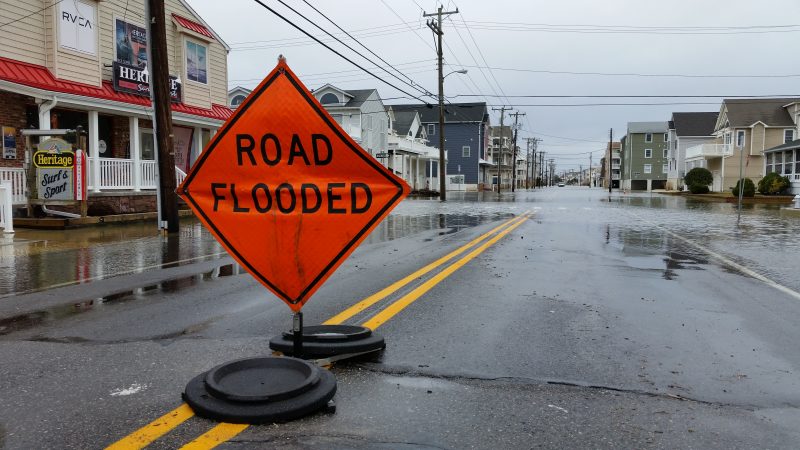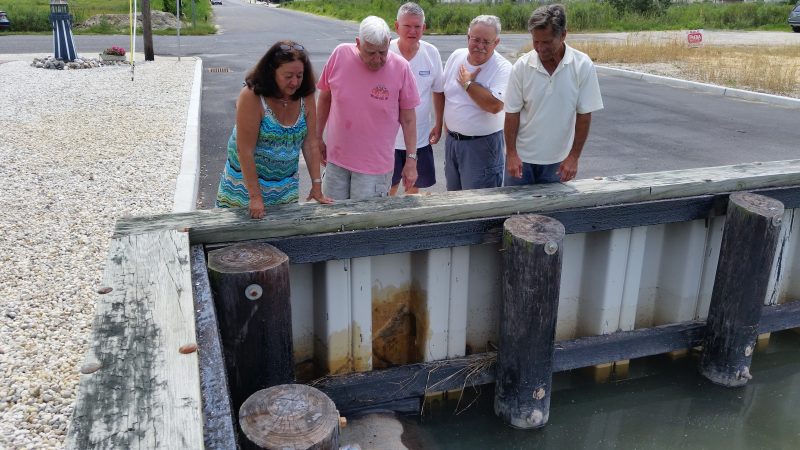As a low-lying barrier island, Sea Isle City is susceptible to flooding.
 By Donald Wittkowski
Heavy rainfall that left many of Sea Isle City’s streets swamped with stormwater on the weekend of July 29-30 was yet another reminder of the flooding problems on the low-lying barrier island.
Almost on a regular basis, residents and business owners appear before City Council to complain about flooding in their neighborhood and demand that something be done to stop it.
At Tuesday’s Council meeting, City Business Administrator George Savastano gave an update on a major flooding study that is moving along in phases and scheduled for completion in August 2018.
City officials have warned that it will take a huge amount of money to finance a comprehensive flooding plan, including the construction of better drainage systems, new pumping stations, dikes and road reconstruction.
Although the study will focus on a long-term strategy, some flood-control measures are underway in Sea Isle or have already been completed, such as beach and dune replenishment projects and new road and drainage improvements.
Savastano reported that a new stormwater pumping station is planned for one flood-prone neighborhood on the bayside of 38th Street. The city’s decision to build a new pumping station in that area follows complaints from homeowners on 38th Street and the adjacent Sounds Avenue about chronic flooding, even during run-of-the mill rainstorms.
“The 38th Street drainage basin has been evaluated for all practical purposes, and we intend to advance a stormwater pumping station project for this area, to be constructed by next spring,” Savastano said.
By Donald Wittkowski
Heavy rainfall that left many of Sea Isle City’s streets swamped with stormwater on the weekend of July 29-30 was yet another reminder of the flooding problems on the low-lying barrier island.
Almost on a regular basis, residents and business owners appear before City Council to complain about flooding in their neighborhood and demand that something be done to stop it.
At Tuesday’s Council meeting, City Business Administrator George Savastano gave an update on a major flooding study that is moving along in phases and scheduled for completion in August 2018.
City officials have warned that it will take a huge amount of money to finance a comprehensive flooding plan, including the construction of better drainage systems, new pumping stations, dikes and road reconstruction.
Although the study will focus on a long-term strategy, some flood-control measures are underway in Sea Isle or have already been completed, such as beach and dune replenishment projects and new road and drainage improvements.
Savastano reported that a new stormwater pumping station is planned for one flood-prone neighborhood on the bayside of 38th Street. The city’s decision to build a new pumping station in that area follows complaints from homeowners on 38th Street and the adjacent Sounds Avenue about chronic flooding, even during run-of-the mill rainstorms.
“The 38th Street drainage basin has been evaluated for all practical purposes, and we intend to advance a stormwater pumping station project for this area, to be constructed by next spring,” Savastano said.

Homeowners look at the stormwater pipe at the bay end of 38th Street that they blame for the flooding in their neighborhood. A new pumping station is planned to alleviate the flooding.
During the July 25 Council meeting, residents of 38th Street and Sounds Avenue criticized the city for a newly installed drainage system in their neighborhood.
They said a new city drainage pipe that is supposed to flush stormwater into the bay at 38th Street has simply been overwhelmed, allowing flooding to inundate the streets.
“You made a mistake, fix it,” Sounds Avenue homeowner Lou Gryga told the Council members after showing them cellphone photos of flooding in the neighborhood.
Savastano met with the homeowners a week later to discuss the flooding problem. The homeowners wanted the city to build a new pumping station. Now, they will get one.
“We want them to shut off the drains and build a pump station,” Gryga said in an interview.
Meanwhile, the city has begun a mapping program to identify stormwater facilities and drainage basins throughout the island as part of the flooding study.
The information needs to be updated to reflect the improvements to the pipe system undertaken by both the city and Cape May County. The mapping phase of the flooding study is expected to be completed by the end of January, Savastano said.
Sea Isle is collaborating with Cape May County on the study because the county controls major parts of the city’s drainage pipes and other flood-control systems.
City officials have noted that the study will look at flooding from a broader, regional perspective, rather than just limiting it to Sea Isle, because that would open up the possibility of securing more public funding to fight the problem.
Once the mapping phase of the study is done, the city will evaluate its drainage systems. Already, the city has begun a preliminary review of some of the areas, including the drainage basin at 59th and 60th streets and another on 55th Street, Savastano said.
Both of those drainage basins cover large areas running from the beach to the bay. They appear to be candidates for stormwater pumping stations, Savastano explained.
“We understand that there are several other problem areas in the city, and ultimately we will develop a recommended priority for advancing improvements,” he said.
Completion of the evaluation phase for the drainage systems is scheduled for late May 2018. If the city hits its target dates, the final flooding study and its recommendations should be ready by the end of August 2018, Savastano said.
 By Donald Wittkowski
Heavy rainfall that left many of Sea Isle City’s streets swamped with stormwater on the weekend of July 29-30 was yet another reminder of the flooding problems on the low-lying barrier island.
Almost on a regular basis, residents and business owners appear before City Council to complain about flooding in their neighborhood and demand that something be done to stop it.
At Tuesday’s Council meeting, City Business Administrator George Savastano gave an update on a major flooding study that is moving along in phases and scheduled for completion in August 2018.
City officials have warned that it will take a huge amount of money to finance a comprehensive flooding plan, including the construction of better drainage systems, new pumping stations, dikes and road reconstruction.
Although the study will focus on a long-term strategy, some flood-control measures are underway in Sea Isle or have already been completed, such as beach and dune replenishment projects and new road and drainage improvements.
Savastano reported that a new stormwater pumping station is planned for one flood-prone neighborhood on the bayside of 38th Street. The city’s decision to build a new pumping station in that area follows complaints from homeowners on 38th Street and the adjacent Sounds Avenue about chronic flooding, even during run-of-the mill rainstorms.
“The 38th Street drainage basin has been evaluated for all practical purposes, and we intend to advance a stormwater pumping station project for this area, to be constructed by next spring,” Savastano said.
By Donald Wittkowski
Heavy rainfall that left many of Sea Isle City’s streets swamped with stormwater on the weekend of July 29-30 was yet another reminder of the flooding problems on the low-lying barrier island.
Almost on a regular basis, residents and business owners appear before City Council to complain about flooding in their neighborhood and demand that something be done to stop it.
At Tuesday’s Council meeting, City Business Administrator George Savastano gave an update on a major flooding study that is moving along in phases and scheduled for completion in August 2018.
City officials have warned that it will take a huge amount of money to finance a comprehensive flooding plan, including the construction of better drainage systems, new pumping stations, dikes and road reconstruction.
Although the study will focus on a long-term strategy, some flood-control measures are underway in Sea Isle or have already been completed, such as beach and dune replenishment projects and new road and drainage improvements.
Savastano reported that a new stormwater pumping station is planned for one flood-prone neighborhood on the bayside of 38th Street. The city’s decision to build a new pumping station in that area follows complaints from homeowners on 38th Street and the adjacent Sounds Avenue about chronic flooding, even during run-of-the mill rainstorms.
“The 38th Street drainage basin has been evaluated for all practical purposes, and we intend to advance a stormwater pumping station project for this area, to be constructed by next spring,” Savastano said.
 Homeowners look at the stormwater pipe at the bay end of 38th Street that they blame for the flooding in their neighborhood. A new pumping station is planned to alleviate the flooding.
During the July 25 Council meeting, residents of 38th Street and Sounds Avenue criticized the city for a newly installed drainage system in their neighborhood.
Homeowners look at the stormwater pipe at the bay end of 38th Street that they blame for the flooding in their neighborhood. A new pumping station is planned to alleviate the flooding.
During the July 25 Council meeting, residents of 38th Street and Sounds Avenue criticized the city for a newly installed drainage system in their neighborhood.